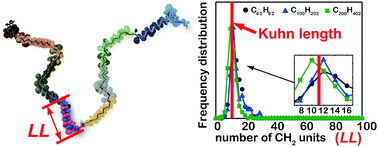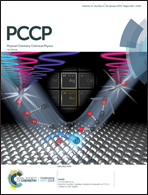Multiscale modeling of charge transfer in polymers with flexible backbones†
Abstract
In order to evaluate the carrier transfer properties in polymers with flexible backbones, we have proposed a simplified multi-scale modeling approach combining molecular dynamics simulations, first-principles calculations and kinetic Monte Carlo simulations. Hole transfer in amorphous polyethylene (PE) is studied as a model system. It is shown that the characteristic length scale of hole localized states in PE is comparable to the Kuhn length of PE, which is the characteristic length scale in terms of the geometric structure. Because a PE oligomer whose length is equivalent to the Kuhn length (C12H26) has a similar electronic structure to amorphous PE, C12H26 is considered as an approximate model of amorphous PE. In line with experimental findings, computed hole mobility in the amorphous PE oligomer is several orders of magnitude smaller than that in crystalline PE. We show that this difference originates from strong hole localization and large site energy variation in amorphous PE due to the conformational disorder of PE oligomer chains. The agreement between experimental and calculated hole mobilities strongly supports the rationale of our modeling approach. The modeling approach proposed in this paper is considered capable of predicting carrier mobilities in polymers with flexible backbones with reasonable computational load.

- This article is part of the themed collection: 2019 PCCP HOT Articles


 Please wait while we load your content...
Please wait while we load your content...